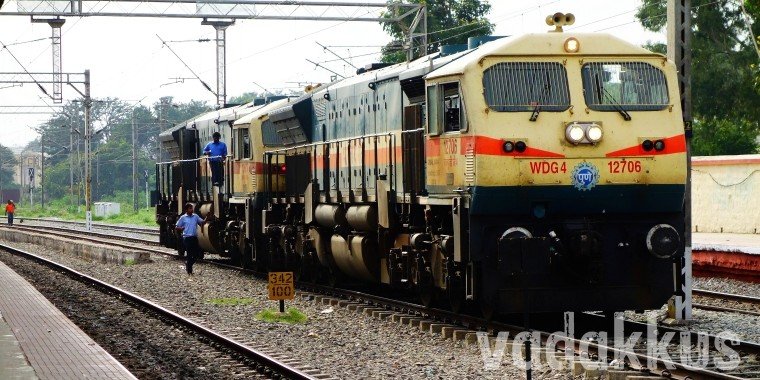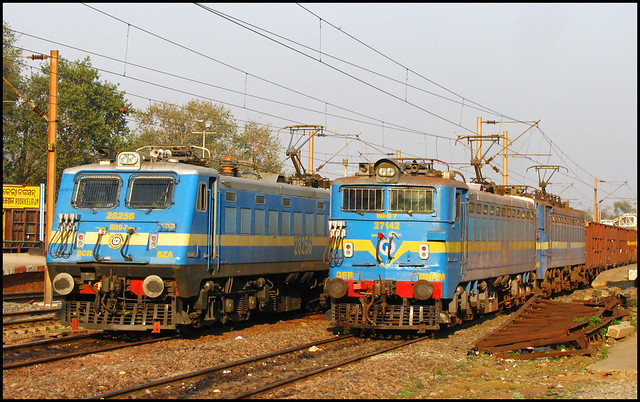Indian Railway Locomotive Terminologies & Design

Locomotives are very complicated and very heavy machinery, which they have to be, given the enormous amount of work they are meant to do. The average Diesel engine inside a locomotive has 16 cylinders (V16) and displaces around 150 liters, while an average car engine has 4 cylinders and displaces 1 or 2 liters. Some cylinders are so big that you can stick your head in them! Diesel fuel tanks can hold 50,000 liters, Superchargers can weigh a tonne, Transformers and Rectifiers can be as big as a hatchback car and traction motors can be as big as a Tata Nano. Everything is enormous about these things which in total weigh upwards of 20 tonnes and cost around 10 Crores a piece! The damn things have to be that powerful, as they need to pull themselves and the entire train as well!
Working techniques and principles of locomotives on a macro scale are basically the same across the World, but on a micro scale, they have to be different. For example, locomotives made to work in Nordic countries or Canada should be created to withstand freezing temperatures with ergonomic and aesthetic cabins while those for India need to work a lot under heavily varied circumstances and should be easy to repair and maintain. Hence they should be made very tough and unrelenting in design. This is why our locomotives are more utilitarian and less aesthetic. The Indian locomotives in service today are the results of decades of experimentation, rebuilding and trial-and-error, resulting in workhorses that work with surprising efficiency. To see how they actually work, we have to first look at some common terminologies associated with Locomotives.

Locomotive Terminology
Locomotive – A vehicle that outputs energy and powers a train along the rails, the only “live” part of the train. The coaches of a train are only pulled or pushed along the rails by the locomotive. There are numerous types of locomotives, but most are powered by either diesel fuel or electricity collected from overhead lines or a third rail. The Locomotive and the engine are two different things.
Engine – Locomotives are popularly called “Engines”, though the engine is only a part of the (diesel) locomotive, while electric locomotives do not have engines at all. The engine is the most important part in diesel locomotives and supply the power to turn the wheels. The engine is also called a “Prime Mover”. These engines are huge, usually having 16 Cylinders, 32 Valves and about 100,000 to 150,000 cc displacement.
Bogie – The Bogie is not, as many people wrongly say it to be, a railway passenger vehicle unit. That is a coach, compartment, carriage or car. A bogie is a unit under a coach or a locomotive body which houses the wheels, suspension etc. Usually there will be two bogies for a coach and two or three for a locomotive with each bogie housing four or six wheels. And it is by no means a bogey, which is something entirely different and has got nothing to do with trains, unless it is in a horror movie.
Wheel Arrangement (WA) – Specifies how many wheels are present on how many bogies of a locomotive. The most common WA today is three wheels on either side on two bogies (3 axles), 12 wheels in total and all axles powered, denoted Co-Co. This is used in locomotives which haul heavy loads, which is 80% of all in India. Two bogies with two wheels on either side and 8 wheels in total all powered is denoted by Bo-Bo, which is good for light, speedy loads. The WAP5 is the only major Bo-Bo locomotive in India.
Driving Cab – The “Cockpit” of the locomotive, where the loco pilot (driver) and assistant and any other sit and drive the loco. All controls etc are located here. The cluster containing the controls to drive the locomotive is called a “Control Stand”.
Pantograph – The arm-like device on the top of the electric locomotive that extends upwards to collect current from the overhead lines. Usually there are two of them for a locomotive, only one will be used at a time.
Shell – The housing body of the locomotive. A WAG7 in a WAP4 shell means a WAG7 equipment housed in the body that is otherwise used for the WAP4. In Diesel locomotives, the shell is also called the “Hood”.
Left (28256): WAG7 in a WAP4 Shell. Right (27142): WAG7s in Original Shell. Everything but the looks is same for the three.
Transmission – The medium used to send the power generated by the diesel engine to the wheels. In modern locomotives, the diesel engine produces electric (AC) current used to power traction motors which turn the wheels. Hence transmission is AC. Vastly different from the traditional automotive sense.
Traction Motors – Electric motors that “actually” drive the wheels of the locomotive and hence the train. These motors are directly connected to axles of the locomotive, usually one per axle. They use the electric power generated by the generator/alternator run by the diesel engine or from the transformers (electric locos) to output mechanical power to turn the wheels and move the locomotive forward.
ALCO – American Locomotive Corporation, Inc. An erstwhile American manufacturer of Diesel locomotives. ALCO supplied India’s first mainline Diesel Locomotive the WDM1 and later the WDM2, which became the mainstay of the Indian Railways. All Indian locomotives except the WDP/G4 are based on the WDM2 and are called “ALCOs”
EMD – Electro Motive Diesel, an American company which manufactures Diesel locomotives and is wholly owned by Caterpillar Inc. It was previously owned by GM (General Motors). EMD supplied the WDP4 and WDG4.
Long Hood Forward (LHF) – This is a driving mode for locomotives when the locomotive is driven with the driving cab behind the longer Hood length of the locomotive body. Visibility might be a problem here and many locomotives have speed controls when driven in LHF. Some like the WDP4 EMDs have been criticized for their too long hoods obscuring visibility.
Short Hood Forward (SHF) – This driving style is the opposite of LHF where the locomotive is driven with the cabin towards the front of the locomotive, behind the shorter “nose” of the loco. This is actually the “forward” operating position of the locomotive, since the long hood is technically the rear of the loco with the radiator, exhaust and all. Dual Cab locomotives do not have LHF/SHF.
Views from ALCO Locomotive Cabins for Locos Driven in LHF and SHF Modes


Locomotive Driving Structure Design
There are three types of locomotive driving structures in India: Single Cab forward, Dual Cab forward and Hood Unit Cab. The Dual Cab Forward type will have cabs or driving cabins at either end of the locomotive facing outwards and is seen in all electric (WAM, WAP, WAG, WCAM etc) and newer diesel (WDP4D, WDP3A) locomotives. This type is the most convenient and safest to operate as it gives the best view for the Loco Pilots (drivers) of the way ahead and does not require “turning” locomotives around. The Single Cab Forward type will have a driving cab at only one end of the locomotive as seen in WDP4 and WDG4 EMD locomotives. This design is intended either to be used with turntables where the locomotive is turned around so that the cab always faces the direction in which the train is moving, or with two locomotives coupled together so that the cabs of both locos face outwards. However, since India does not have turntables, WDP/G4s are to be driven in Long Hood Forward mode and hence has control stands facing the other direction as well. WDP/G4s have a very very long hood and and have been criticized for being “unsafe” because of visibility issues. The WDP4D was the result of this criticism with an additional cab added on the LHF end.
The third type is called the Hood Unit Cab, the most widely seen cab structure found on all ALCO diesel locomotives except the WDP3A in India (WDM2, WDM3X, WDG3X etc). The cab is located close to but not at the exact end of the locomotive, at around three-fourths of the locomotive length. The body shell of the loco will be narrower than the superstructure to enable visibility from the cab which will extend to the full width of the body with narrow windows for forward visibility. The loco pilot will have a view of only one side at one time and not of the entire area in front of the locomotive. The loco will also have two control stands, one each facing opposite left sides in the cab so that the driver will always be able to face forward no matter which direction the locomotive is going, be it LHF or SHF. So in India there is no “reverse” mode for railway locomotives unlike in some American ones, like the one driven by Denzel Washington in the movie “Unstoppable”. All locomotives in India are left hand driven because the signals are located on the left side of the track, and trains always run on the left one of the two tracks, just like on roads.
Hood Unit Cabs: Driving towards us, the Blue TKD WDP1 is in LHF mode (driver on the other side) and the Orange WDM3A is in SHF mode.
So why use other designs when Dual Cab-Forward mode should obviously be the design of choice for locomotives? During the days when were all about diesels (1960s), the Hood Unit Cab design was the in thing and a design breakthrough. In one stroke it both saved the cost of making two cabs and eliminated the need for turntables as one could just switch control stands to “turn” the loco around with minimum effort and time. Speed, aesthetics etc didn’t matter in those days. But as time and technology progressed, we remained stuck in the past even when the World had moved on. The Hood Unit Cab design belongs to an ancient era. When we acquired EMD locos 40 years later, we still went with the single cab forward design to keep costs low! That was a bad decision and the WDP4D is the result. Electric locomotives have always had dual cab forward designs and all locomotives except the WDM3D produced in India today are of the dual-cab forward design and this will be the norm going forward. But the Hood Unit Design sure evokes nostalgic memories in many people and not just Railfans, of the days when the ALCO was the beginning and end of Railway engines in India.
The Next Part will detail how these behemoths actually work and how they pull tens of thousands of tonnes of load without breaking a sweat.
More Chapters on Indian Locomotives
Locomotives of the Indian Railways | Locomotives Terminologies and Design
How Locomotives are Classified | How Electric and Diesel Locomotives Work
DIESELS: The WDM Series (ALCOs) | The WDP and WDG Series (ALCOs and EMDs)
ELECTRICS: DC and AC/DC Locos | The WAM Series (AC mixed) | The WAG Series (AC Freight)







thanks for this post 🙂